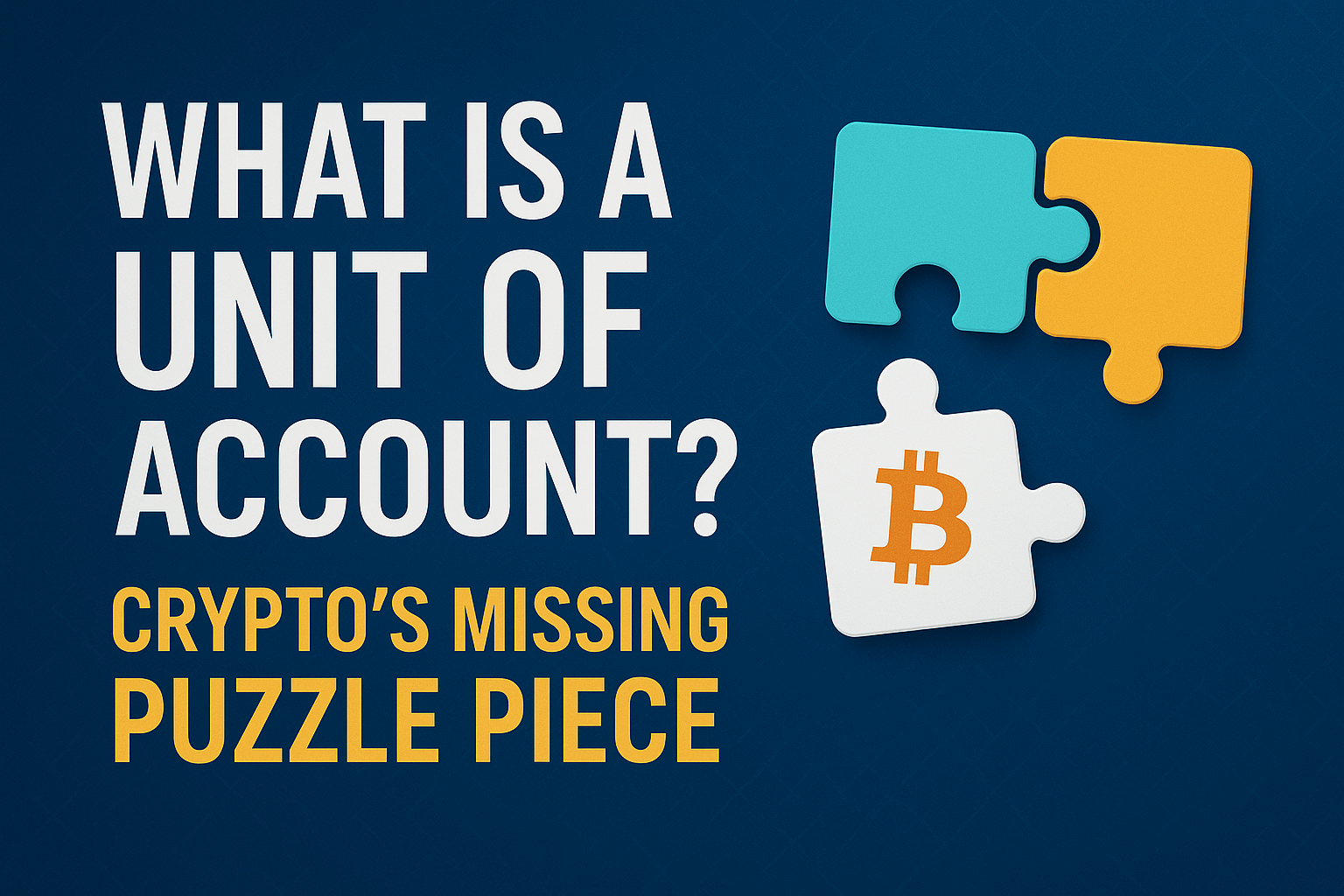Unit of account is a basic and fundamental economic function which means a way to measure the value of anything. In simple words, it is a common standard through which we express prices. Like rupee, dollar or euro – these are all units of account because we write the value of our products, services and contracts in them.
In traditional economics, the role of unit of account is through stable and predictable currency. For example, if you buy a pen, its price is 50 rupees, and everyone understands this because rupee is a common reference for everyone. This is why businesses can do budgeting, consumers can make comparisons and governments can collect taxes.
But when we enter the world of crypto, this puzzle piece seems to be missing. Cryptocurrency has not yet become a fully unit of account because its value changes very frequently. The price of coins like Bitcoin and Ethereum can change by 5%, 10% or more in a day, which makes it unstable to define any product or salary in their value.
That is why, when we say that unit of account is the missing puzzle piece for crypto, it means that until cryptocurrencies establish a reliable and consistent pricing standard, their full integration into the traditional financial system will be difficult.
Also earn latest new about Trump Crypto News 2025 – Latest Updates & Policies
Table of Contents
2. Why Unit of Account Status Matters for Cryptocurrency
Unit of account status is important for any currency because it defines the daily utility of that currency. Until people can reliably express the price of something in a currency, that currency remains a speculative asset, not a practical payment or accounting tool.
If cryptocurrency is to be adopted mainstream, it is necessary for it to have a unit of account. Today, if the price of coffee is written in BTC in a coffee shop and it is 0.0003 BTC in the morning but by the evening it becomes 0.0004 BTC, then both the merchant and the customer will be confused. This uncertainty is why businesses do not take crypto seriously.
Another angle is legitimacy. Government-issued currencies like the dollar or euro are stable because they have backing, regulation, and widespread trust. If crypto does not achieve the function of a unit of account, it will never gain the level of trust of central banking or institutional finance.

3. Real-World Examples: Is Any Crypto Truly a Unit of Account?
If we look at practical examples, Bitcoin (BTC) has been used as a unit of account at times, but on a limited scale. When El Salvador made BTC a legal tender, their goal was that people could price their daily lives in BTC. But the ground reality is that people there mostly use USD too.
Stablecoins like USDT (Tether) and USDC (USD Coin) are more reliable for this role, as their value is pegged to fiat currency. Today stablecoins have mostly become the pricing standard in DeFi platforms, crypto exchanges, and Web3 apps. These coins are being used in daily transactions, lending protocols, and salary contracts.
CBDCs (Central Bank Digital Currencies) have also entered this race. China’s Digital Yuan and Europe’s proposed digital euro are seriously pushing this concept, as they are state-backed and price-stable. But their blockchains do not have much to do with decentralization, which is why they get mixed responses in the crypto community.
4. The Volatility Problem: Crypto’s Biggest Barrier
Cryptocurrency’s volatility is the biggest hurdle in preventing it from becoming a unit of account. When the value of an asset changes every day, sometimes down 15%, sometimes up 20%, no business or individual will define their salary or pricing in that asset.
Bitcoin and Ethereum both have developed the status of a store of value, but without price stability, it is practically impossible for them to become a pricing unit. If you are a freelancer who charges for your service in BTC, you have to re-calculate after each project what your actual income was.
Volatility makes accounting, tax calculation and daily trade impossible. Until this problem is solved, the unit of account function of crypto will remain limited.
5. Stablecoins: The Bridge to Unit of Account Functionality
Stablecoins have given the crypto world a working solution. Their value is mostly pegged to the USD, which makes them predictable and practical. For example, USDT and USDC are coins that hover around 1 USD, which brings stability to DeFi apps, payroll systems and smart contracts.
DeFi protocols like Aave, Compound, or Uniswap define rates for borrowing, lending and yield farming in these stablecoins. That is, the unit of pricing and accounting has already become a stablecoin — the real daily use case of crypto is now developing around stablecoins.
Stablecoins have given crypto a foundation where people can define their pricing, savings and contracts without the stress of volatility.
6. Unit of Account vs. Store of Value: Key Differences
Many people get confused between these two terms. Store of value means an asset in which you can save long-term value. Bitcoin is called “digital gold” because people use it as a hedge against inflation.
But the function of a unit of account is completely different. It is a measurement tool where you define the price. Gold or Bitcoin store value, but you don’t pay for groceries or rent in gold. Similarly, while the price of Bitcoin is so volatile, it is unrealistic to make it a pricing unit.
The point to understand is that an asset can be a store of value without being a unit of account. But a successful currency must perform both functions.
7. How Blockchain Technology Enables Unit of Account Use
The most powerful feature of blockchain is programmable money. Smart contracts and oracles like Chainlink allow the crypto ecosystem to trustlessly fetch real-world data. This means you can write a smart contract that automatically makes payments to someone based on a USD price feed.
For example, if a freelancer does contract is in USDC and it receives 1000 USD every month, it will be fixed and predictable, without any volatility. This feature is not present in traditional contracts.
Oracles update the system with real-time data, which is used in DeFi, insurance and payroll systems. The transparency and automation of blockchain has made unit of account use cases technically possible, now only mass adoption and regulation are lacking.
8. Challenges Holding Crypto Back from Becoming a Pricing Standard
Crypto’s unit of account function has not yet become mainstream because of some fundamental challenges. The first challenge is regulation. Every country has a different stance on crypto policy. Until there is legal clarity, businesses will remain hesitant.
Another barrier is merchant adoption. Most retailers still define price in fiat currencies. The tools and infrastructure to accept crypto payments are limited and complex.
Scalability is also an issue. If the blockchain network becomes expensive, slow or congested, daily payments become impossible. Apart from this, public trust is also missing — people still consider crypto as a speculative or risky asset, not a currency.
Also learn about What is Wrapped Bitcoin (WBTC)
9. Future Outlook: When Will Crypto Achieve Unit of Account Status?
If current trends are to be believed, CBDCs and regulated stablecoins have the most potential to achieve unit of account status. Governments like China, UAE, and EU are launching their own digital currencies that are legally accepted and stable.
In hyper-inflation economies like Venezuela or Zimbabwe, crypto adoption is happening naturally because their local currency has become unreliable. Such environments put crypto on a fast track to becoming a pricing unit.
If crypto-friendly regulations, fast blockchains, and public awareness grow in parallel, stablecoins or hybrid models could become the pricing standard in the next 5-10 years.
Check the latest article about How to Recover Stolen Crypto
10. Steps Toward Adoption: What Businesses & Investors Should Watch
If you are a business or investor, the first step is to closely track stablecoin regulations. New frameworks are being developed in the USA, EU, and Asia that will decide which coins are compliant and which are risky.
Secondly, exploring operations in crypto-friendly jurisdictions such as Dubai, Singapore, and Switzerland could be a smart move. Crypto adoption is happening faster in these regions, and you also get legal support.
Thirdly, it’s important to keep an eye on payments innovations, as Visa and Mastercard are now supporting crypto transactions. Businesses that adopt these tools first will be future-ready.
Can Bitcoin become a unit of account?
Not yet, because the price of Bitcoin is very volatile. Until its value is stable, it cannot become a pricing standard. People still use BTC mostly as a store of value or investment asset.
Why are Stablecoins becoming a unit of account?
The value of Stablecoins like USDT and USDC is pegged to USD, which makes their pricing and payments easier. DeFi apps and smart contracts are already using them to define prices.
Has El Salvador made Bitcoin a unit of account?
They have created a legal tender but in the real-world, people mostly use USD. BTC’s volatility limits its use as a pricing standard.
Are CBDCs the future of crypto as a unit of account?
CBDCs are state-backed and have stable pricing, so they have the potential to become a trusted unit of account in the crypto space — but their decentralization is low.
What should businesses do if they want to bring crypto into their pricing?
They should first understand the regulation of stablecoins, then explore crypto payment gateways such as CoinPayments, BitPay or Stripe Crypto. Along with this, they will have to keep their compliance and accounting software updated.





